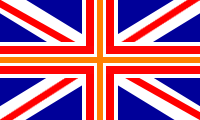mNo edit summary |
No edit summary |
||
| Line 21: | Line 21: | ||
|} |
|} |
||
| − | '''The United Kingdom of Great Britain, the Netherlands, and Ireland''' (usually referred to as simply the United Kingdom or Britain) was a nation located in Europe. At its height, it |
+ | '''The United Kingdom of Great Britain, the Netherlands, and Ireland''' (usually referred to as simply the United Kingdom or Britain) was a nation located in Europe. At its height, it incorporated the modern nations of {{TJ|England}}, {{TJ|Scotland and Wales}}, {{TJ|Ireland}}, the {{TJ|Netherlands}} and {{TJ|Belgium}}. |
== History == |
== History == |
||
Revision as of 02:49, 24 May 2005

| |
| Official Languages (national) | English, Dutch |
| Official Languages (regional) | Welsh, Scots Gaelic, Scots, Irish Gaelic |
| Capital | London |
| Last King | Albert |
| Prime Minister | |
| Unification | 1817 |
| Dissolution | 1893 (replaced by Republic of Great Britain and Ireland) |
| Currency | British Pound |
The United Kingdom of Great Britain, the Netherlands, and Ireland (usually referred to as simply the United Kingdom or Britain) was a nation located in Europe. At its height, it incorporated the modern nations of England, Scotland and Wales, Ireland, the Netherlands and Belgium.
History
The components of the United Kingdom have a long history. The present government is, to a large extent, derived from the historical kingdom of Wessex, which conquered its neighbors in the 10th century to form the new kingom of England. England gradually expanded, conquering Wales and Ireland, as well as attempting, unsuccessfully, to conquer Scotland. In 1603, King James VI of Scotland became James I of England, establishing a lasting personal union. In 1689, James VII and II was deposed and replaced by William, Prince of Orange, stadtholder of the Netherlands (or rather, most of them), who became King William III of England and Ireland and II of Scotland. Prince William was married to Princess Mary, the daughter of James VII/II. The two reigned as co-monarchs until William's death. Mary produced a single surviving son, who became King William IV upon his mother's abdication. Britain, Ireland, and the Netherlands were now established in a lasting personal union. The Netherlands were centralized, with their separate provincial stadtholders abolished to be replaced by a single stadtholder, now seen as equal to a King.
In 1752, the separate kingdoms of England, Scotland, and the Netherlands were abolished, merged into a single United Kingdom of Great Britain and the Netherlands. Ireland remained outside of this united kingdom, held by personal union alone.
During the Second Global War, France occupied the Netherlands and Ireland, setting up puppet governments. After Napoleon's fall, the British government sought to reunify its lost components, passing the Reunification Act, which established the United Kingdom of Great Britain, the Netherlands, and Ireland, consisting of four states, England, Scotland, Ireland, and the Netherlands.
The Netherlands were lost in the Third Global War, and shortly afterwards, the Republic of Britain and Ireland was proclaimed, abolishing the monarchy. This was a unitary, Anglocentric, republic. It soon broke apart as Scotland and Ireland declared independence, and the Republic gave way to the Second English Commonwealth, which still contained Wales. Wales subsequently broke off to join Scotland.
Politics
The United Kingdom was subdivided into 4 states, England, Scotland, Ireland, and the Netherlands, each of which had its own parliament with a degree of legislative authority from the central government. The United Kingdom, in turn, had its own parliament.
Currency
The currency of the United Kingdom was the pound (£). The pound was divided into 20 shillings, each of which were divided into 12 pence (d). After the Third Global War, the pound suffered a period of hyperinflation, with banknotes as large as 10 billion pounds being printed.
List of Monarchs of the House of Orange-Nassau
Kings and Queens of England, Scotland, and Ireland, and Stadtholders of the Netherlands
- 1689-1702 William III (II of Scotland) and Mary II
- 1702-1715 Mary II (abdicated)
- 1715-1749 William IV/III
- 1749-1752 William V/IV
Kings of the United Kingdom of Great Britain and the Netherlands and of Ireland
- 1752-1756 William V/IV
- 1756-1792 Henry IX and I
- 1792-1817 George I
Kings of the United Kingdom of Great Britain, the Netherlands, and Ireland and of America
- 1817-1854 George I
- 1854-1865 George II
- 1865-1884 George III
- 1884-1893 Albert
In 1893, the monarch was abolished, and Albert fled to Philadelphia, in the North American Confederation, adopting the title King of the Commonwealth of British Nations
